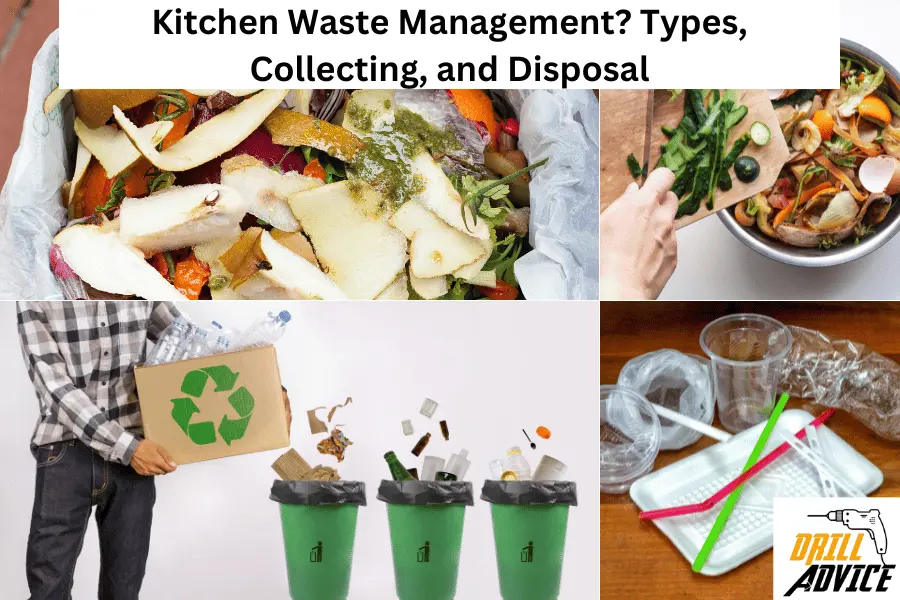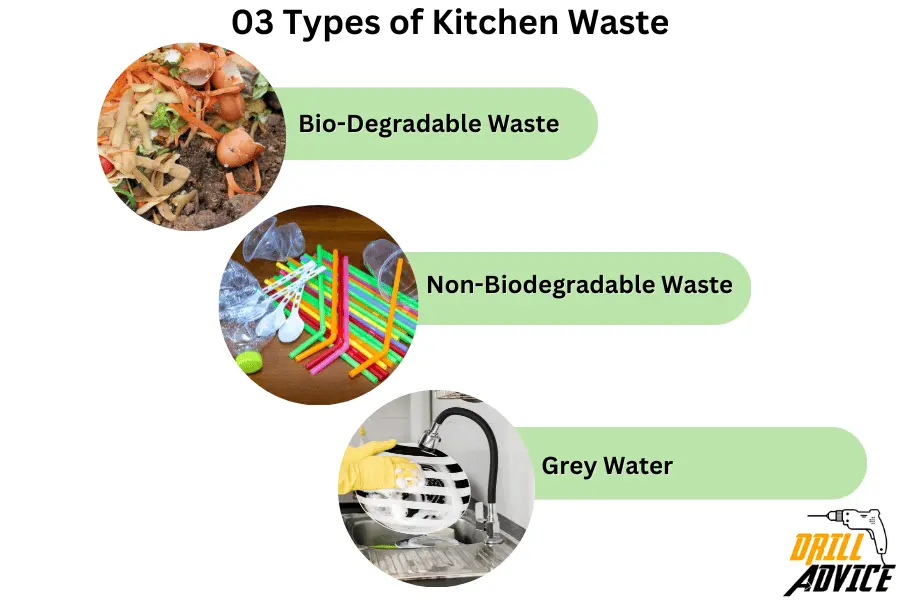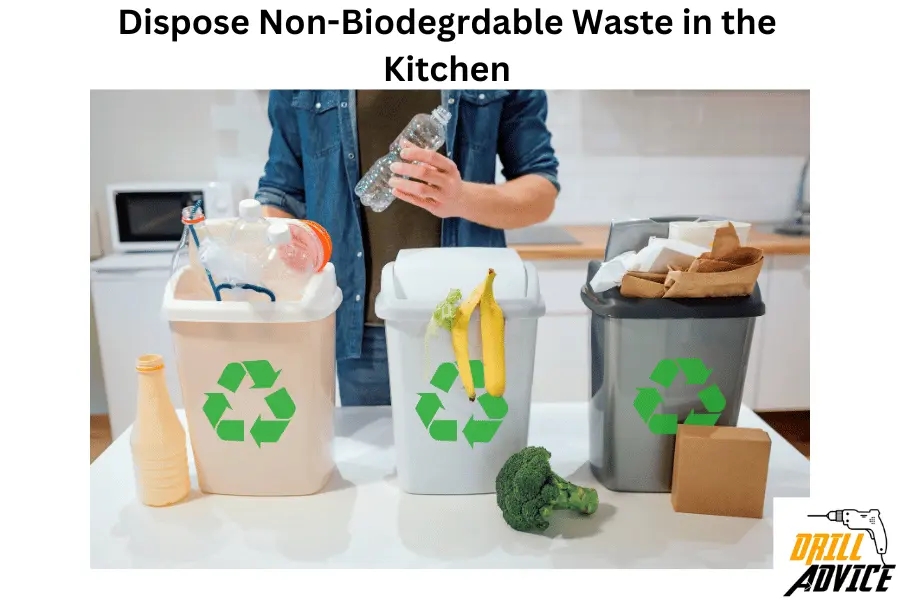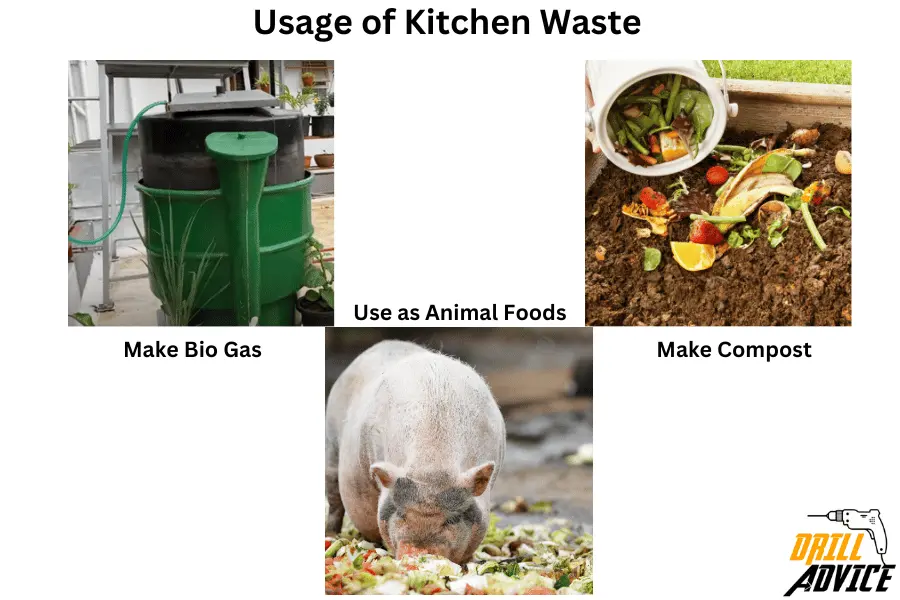
Kitchen waste is mainly 3 types such as biodegradable waste, non-biodegradable waste, and wastewater. This waste should be collected using proper collecting ways and disposed them in proper places in order to prevent environmental pollution. Kitchen waste can be used to produce biogas, compost and animal feeds. Kitchen waste generation can be reduced.
Biodegradable waste is organic waste in the kitchen, and it can be decomposed easily. Non-biodegradable waste in the kitchen can not be broken down by bacteria. Hence those are undecomposed. Wastewater is the generated water from the washing activities in the kitchen. All of these waste types should collect using proper collecting methods before disposal.
Biodegradable waste can be collected to the bin in the kitchen, and non-biodegradable should be collected and sorted by plastic, polythene, glass, and metals. These should be handed over to the recycling places. Wastewater can be collected to the pit or basin.
Biodegradable waste can be disposed to the environment, and non-biodegradable should be recycled. Wastewater can be use for plants. During the non-biodegrdable disposing, those should not burn, and waste water should not release to the water source directly. Because these contain harmful contaminants.
Kitchen waste can be used to produce biogas and composite which is the solution for power and fertilizer. Kitchen waste can be used as animal feeds also. Kitchen waste can be reduced by planning meals, buying in bulk, avoiding single-use items, storing food properly, using up leftovers, and composting kitchen scraps.
What are the Types of Waste in the Kitchen?

The kitchen waste is mainly three types. Those are biodegradable waste, non-biodegradable waste, and wastewater. Biodegradable waste is decomposed waste, and non-biodegradable waste can not be broken down easily in the environment. Grey water is the washing water of food and dishes.
1. Bio-Degradable Waste
Bio-degradable waste in the kitchen is organic waste that can naturally decompose over time. This type of waste includes food scraps, peels, and leftovers. This waste can be broken down by microorganisms and turned into compost. The problem of bio-degradable waste is that if it is not managed properly, it can attract pests and create unpleasant odors in the kitchen.
2. Non Biodegradable Waste
Non-biodegradable waste, on the other hand, does not break down easily and can persist in the environment for a long time. This type of waste includes materials like plastic bags, packaging materials, and disposable utensils. Since non-biodegradable waste cannot be decomposed naturally, it is important to find proper ways to manage it. The problems of nonbiodegradable waste are water source pollution and soil pollution during the landfills.
3. Grey Water
Grey water is another type of waste that is generated in the kitchen. Grey water is the wastewater that comes from activities like washing dishes, fruits, and vegetables. Grey water contains traces of food particles, grease, and cleaning products. Grey water contains harmful contaminants. It is important to properly manage grey water to prevent contamination of water sources and maintain hygiene.
Read More About
- Best 8 Ways to Remove Stain Marks in the Kitchen: Methods and Products
- 7 Ways to Remove Cooking Odors in the Kitchen: Ingredients and Methods
How to Collect Kitchen Waste?

Kitchen waste should be collected separately. Biodegradable waste should be collected in bins or containers with no leaking outside. Non-biodegradable waste should be collected by separating glass, polythene, and metal, as it can dispose to recycling. Waster water can be collected in the pit basin or can. In the urban area, wastewater can be released to suitable waste lines without collecting.
How to Collect Biodegradable Waste in the Kitchen?
Biodegradable waste in the kitchen includes food scraps, vegetable peels, fruit peels, tea bags, and other organic materials that can break down naturally over time. These types of waste can be collected separately from other waste and used for composting.
Composting is a process of breaking down biodegradable waste into nutrient-rich soil that can be used in the garden or potted plants. To collect biodegradable waste in your kitchen, you can use a compost bin or a separate container. You should empty the bin regularly and transfer the waste to an outdoor composting area.
How to Collect Non-Bio Degradable Waste in the Kitchen?
Non-biodegradable waste in the kitchen includes plastic packaging, aluminum foil, and glass bottles. Non-biodegradable waste should be collected properly. Because non-biodegradable waste does not break down naturally and can cause harm to the environment if not disposed of properly.
It is important to collect and separate non-biodegradable waste from other waste to ensure proper recycling or disposal. You can use separate containers for different types of non-biodegradable waste, such as a recycling bin for plastic, glass, and metal items. As well as you should use a separate container for general trash.
How to Collect Grey Water in the Kitchen?
Grey water in the kitchen can be reused for other purposes, such as watering plants or cleaning. To collect grey water in the kitchen, you can place a bucket or a basin in the sink to collect the water while you’re washing dishes or vegetables.
Make sure to filter out any solid particles before reusing the grey water. If you are in an urban area, you should dispose of the grey water to a suitable wastewater system according to the rules and regulations.
How to Dispose of Kitchen Waste?
Kitchen waste disposal is the process of getting rid of waste materials safely and responsibly. Proper waste disposal is essential for maintaining a clean and healthy environment in your home.
Improper disposal of kitchen waste can lead to a range of problems. These are the issues due to 3 main types of waste.
- Biodegradable waste can produce unpleasant odors and attract pests if not disposed of correctly.
- Non-biodegradable waste can take a long time to decompose and contribute to pollution in the environment.
- Greywater can contaminate water sources and harm the ecosystem if not disposed of properly.
The most important of kitchen waste disposal is to maintain a clean and hygienic living environment in the home. Proper waste disposal can prevent the spread of bacteria and the attraction of pests, leading to health problems.
Secondly, proper waste disposal is essential for protecting the environment. The waste recycling process can reduce the amount of waste that ends up in landfills and minimize our impact on the planet.
How to Dispose of Biodegradable Waste in the Kitchen?
Bio-degradable waste can be decomposed into the environment directly. Because biodegradable waste can break down easily in the enviroment. Therefore biodegradable waste can be used to make compost.
Composting is a natural process where organic waste breaks down into nutrient-rich soil. You can set up a compost bin in your backyard or use a composting system suitable for indoor use.
How to Dispose Non-Biodegrdable Waste in the Kitchen?

Non-biodegradable waste should be collected and recycled whenever possible. Non-biodegradable waste such as plastic, glass, metal, and paper can be recycled and turned into new products. You have to collect them separately to dispose them.
You can check with your local recycling facilities to understand what materials they accept and how they should be sorted. Additionally, try to reduce your use of single-use plastics by opting for reusable alternatives like cloth bags and containers.
Can I Burn Non-Bio-Degradable Waste in the Kitchen?
You should not burn non-biodegradable waste in the kitchen. The most non-biodegradable waste in the kitchen are polythene, plastic, and glass. When polythene and plastic are burned, it emits harmful gases such as CO, Nitrogen Oxides, Sulfur Dioxide, polycyclic aromatic hydrocarbons (PAHs), dioxins, and furans. These are toxic and badly affect for humans, animals’ respiratory systems, and the environment. Hence nonbiodegradable waste in the kitchen should not burn.
How to Disposal Grey Water in the Kitchen?
Grey water can be reused for certain purposes, such as watering plants or cleaning. However, it’s essential to filter out any solid particles before reusing grey water to avoid clogging pipes or contaminating the soil.
You can collect grey water by placing a bucket or basin in the sink while washing dishes or fruits. Just make sure to use the grey water promptly and avoid storing it for too long.
Can I Dispose Grey Water to the Water Source?
You should not dispose the kitchen greywater to the water source. Grey water contains contaminants of oil, soap, and detergents. These contaminants are harmful to the biological systems. Hence grey water should not dispose to water sources.
What Are the 3 Main Usage of Kitchen Waste?

Kitchen waste can be used for main 3 usages such as making biogas, making compost, and use as animal food. Biogas is a renewable energy source, and compost is an organic fertilizer mixer which are suitable for garden plants. You can feed chickens and pigs using the waste food easily.
Make Bio Gas
Biogas is a type of renewable energy that is generated through the decomposition of organic waste materials in the kitchen. Biogas is produced in an anaerobic environment using organic matter such as food scraps and vegetable peels in the kitchen. When the waste is placed in a biogas digester, where bacteria break it down and produce methane gas. This methane gas can then be used as a source of energy for cooking in the kitchen.
Biogas is an alternative and sustainable source of energy. It reduces the usage of non-renewable fossil fuels. By using biogas, we can decrease our carbon footprint and contribute to mitigating climate change.
Make Compost
Another useful way to manage kitchen waste is through composting. Composting is a natural process that involves the decomposition of organic waste materials, such as food scraps, leaves, and garden trimmings, into nutrient-rich soil called compost. This compost can be used as a natural fertilizer for plants and gardens, providing essential nutrients to support their growth.
Composting kitchen waste can reduce the amount of waste sent to landfills, minimizing the release of greenhouse gases and leachate that can harm the environment. Composting helps to enrich the soil with organic matter, improving its structure, water-holding capacity, and nutrient content. This improves healthy plant growth and reduces the need for chemical fertilizers, making it an eco-friendly and cost-effective option for gardening and farming.
Use as Animal Foods
Kitchen waste can also be utilized as animal food. Some food scraps and leftovers that are safe for consumption can be given to animals as a source of nutrition. For example, vegetable peels, fruit scraps, and bread crusts can be fed to chickens, pigs, or even composting worms. By feeding animals with kitchen waste, we can reduce food waste and provide additional nourishment for them, contributing to sustainable agricultural practices.
How to Reduce Waste in the Kitchen?
Reducing waste in the kitchen is an important step towards a more sustainable and eco-friendly lifestyle. Here are some tips on how to reduce waste in the kitchen:
- Plan your meals: Before grocery shopping, plan your meals for the week. This will help you buy only what you need and avoid unnecessary food waste in the kitchen.
- Buy in bulk: Whenever possible, buy ingredients in bulk instead of individually packaged items. This reduces non-biodegradable kitchen waste and allows you to portion out ingredients according to your needs.
- Avoid single-use items: Use reusable items instead of single-use items. For example, use cloth napkins instead of paper ones, refillable water bottles instead of disposable plastic bottles, and reusable shopping bags instead of plastic bags for kitchen use.
- Store food properly: Properly storing food can help extend its shelf life and prevent spoilage. Use airtight containers or reusable wraps to keep food fresh. Label leftovers with dates to ensure they are consumed in a timely manner.
- Use up leftovers: Be creative with your leftovers to minimize food waste. Incorporate them into new meals or freeze them for future use. You can also have a “leftover night” where everyone can enjoy a variety of leftover dishes.
- Compost kitchen scraps: Instead of throwing away fruit and vegetable scraps, coffee grounds, and eggshells, set up a compost bin in your backyard or use a composting system suitable for indoor use. Composting turns these scraps into nutrient-rich soil that can be used for gardening.
- Practice portion control: Serve smaller portions and allow people to take seconds if they are still hungry. This reduces the amount of food waste generated during meals.
- Preserve food: If you have excess produce, consider preserving it by canning, pickling, or freezing. This helps prolong the shelf life of fruits and vegetables and reduces waste.
